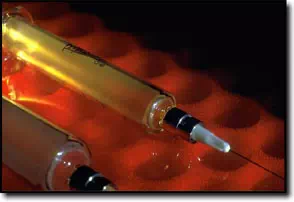Back
to the

State-by-State
Regulated Medical Waste Resource Locator


 |
 Washington
Biomedical
Waste
Definition of Biomedical Waste
Managing Biomedical Waste
OSHA Regulations
Statutes, Regulations
and Guidelines
Contacts
More Information
Definition of Biomedical Waste
"Biomedical waste" means, and is limited
to, the following types of waste:
- "Animal waste" is
waste animal carcasses, body parts, and bedding of animals that
are known to be infected with, or that have been inoculated with,
human pathogenic microorganisms infectious to humans;
- "Biosafety level 4
disease waste" is waste contaminated with blood, excretions,
exudates, or secretions from humans or animals who are isolated
to protect others from highly communicable infectious diseases
that are identified as pathogenic organisms assigned to biosafety
level 4 by the centers for disease control, national institute
of health, biosafety in microbiological and biomedical laboratories,
current edition;
- "Cultures and stocks" are
wastes infectious to humans and includes specimen cultures, cultures
and stocks of etiologic agents, wastes from production of biologicals
and serums, discarded live and attenuated vaccines, and laboratory
waste that has come into contact with cultures and stocks of etiologic
agents or blood specimens. Such waste includes but is not limited
to culture dishes, blood specimen tubes, and devices used to transfer,
inoculate, and mix cultures;
- "Human blood and blood products" is
discarded waste human blood and blood components, and materials
containing free-flowing blood and blood products;
- "Pathological waste" is
waste human source biopsy materials, tissues, and anatomical parts
that emanate from surgery, obstetrical procedures, and autopsy. "Pathological
waste" does not include teeth, human corpses, remains, and
anatomical parts that are intended for interment or cremation;
and
- "Sharps waste" is
all hypodermic needles, syringes with needles attached, IV tubing
with needles attached, scalpel blades, and lancets that have been
removed from the original sterile package.
Managing Biomedical
Waste
In Washington, local governments primarily
regulate medical waste. As a general rule, biomedical waste generators
must segregate the waste and treat it before disposal. If the generator
treats the waste onsite, they most likely have to obtain a permit from
the health department.
The state's definition of biomedical waste is the
sole definition for biomedical waste within the state, and shall preempt
biomedical waste definitions established by a local health department
or local government.
Managing Infectious Waste
Manage infectious wastes in accordance with local
health department requirements. Contact a reliable vendor that picks
up and disposes infectious or biohazardous wastes. Follow the vendor's
protocols on management and packaging. Follow established safety procedures
when working with infectious wastes.
Managing Non-Infectious Waste
Non-infectious solid waste can be disposed of in
the garbage.
Managing Mixed Infectious/Hazardous Waste
Some infectious wastes are also hazardous wastes.
For example, a syringe that contained flu vaccine with thimerosol (the
RCRA-regulated component) as a preservative and was partially injected
into a patient is considered both infectious and hazardous. Another
example of mixed infectious and hazardous waste is a partially administered
IV bag that still contains a P-listed or U-listed chemotherapy drug.
Wherever possible, segregate these wastes. In the flu vaccine example,
remove the sharp from the syringe and place it in the sharps container.
Then place the barrel of the syringe with the remaining vaccine in
the hazardous-waste container. In the IV example, separate the infectious
component (the sharp and T-interlock) from the non-infectious component
(the tubing and reservoir). Place the sharp and T-interlock in the
sharps container and the non-infectious, hazardous-waste tubing and
reservoir into the hazardous-waste container. At all times, keep safety
foremost in your mind and use adequate personal-protective equipment.
If you have mixed infectious / hazardous waste that meets the definitions
of Washington state's conditional exclusion, contact your vendor or
solid-waste incinerator to find out if this waste is accepted and how
to prepare it for the facility. If an in-state incineration facility
meeting the state's specifications is unable to accept conditionally
excluded wastes because it is infectious, it may be necessary to find
a RCRA-permitted incinerator that is capable of managing infectious
wastes.
Washington recommends the following practices for managing infectious,
hazardous wastes:
- Do a physical segregation of infectious and non-infectious
hazardous wastes:
- Manage the non-infectious hazardous wastes as specified.
- Consider whether on-site disinfection of infectious
hazardous wastes is an option. Some methods of disinfection include:
- Microwave;
- Chemical (e.g., bleach or gluteraldehyde);
- Autoclave;
- Ultraviolet-light exposure; and
- Sterilization.
- If waste can be safely rendered non-infectious,
do so and manage as hazardous waste.
- If waste cannot be safely rendered non-infectious,
contact the Washington State Department of Ecology. The management
of each waste will be considered on a case-by-case basis.
OSHA
Regulations VetCA OSHA State Page
In addition to the state medical waste environmental
regulations there are some Occupational Safety and Health Administration
(OSHA) rules that apply to medical/infectious waste. Washington
is one of 21 states operating an approved occupational safety and health
program. This program is operated by the Department of Labor and Industries.
OSHA rules (Occupational Exposure to Bloodborne Pathogens Standards)
impact various aspects of medical/infectious waste, including management
of sharps, requirements for containers that hold or store medical/infectious
waste, labeling of medical/infectious waste bags/containers, and employee
training. These requirements can be found in the VetCA section
entitled OSHA Standards for Regulated Waste.
Statutes, Regulations and
Guidelines
Chapter
70.95K RCW - Biomedical Waste
Contacts
Washington
State Department of Ecology
More Information
Washington
State Department of Ecology - Hazardous Waste & Toxics Reduction
Program
Environmental Concerns about Dental Wastes
Installing Amalgam Separators & Managing Amalgam Wastes
Best Management Practices for X-ray wastes
Best Management Practices for disinfecting/cleaning solutions
|

